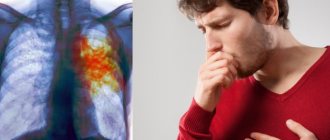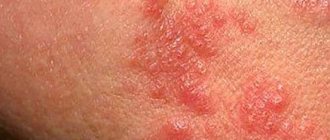Means for the discharge of moctors - how to improve the discharge of viscous sputum?
One of the reasons why sputum is poorly discharged is its increased viscosity. In this case, it must be made more liquid. Warm drinks in the form of weak tea, fruit drinks, juice, herbal decoctions and still water are one of the best remedies that have a thinning effect. It is also useful to eliminate dry air in the room: humidified inhaled air helps relieve coughs with difficult-to-clear sputum. Medicines for sputum discharge, those with expectorant, mucolytic and bronchodilator effects, such as Doctor MOM® herbal syrup, also help remove sticky mucus and relieve dry cough.
Treatment
Help before diagnosis
Long-lasting, regularly expectorated sputum is a reason for a mandatory visit to the doctor. If you are coughing up liquid purulent contents with your mouth full, there is hemoptysis or rust-colored sputum, a visit to a medical facility should be urgent. Before making a diagnosis, it is recommended to drink plenty of warm alkaline drinks, expectorant herbal teas and medications, and breathing exercises.
Conservative therapy
There are a large number of pathologies in which sputum is coughed up; treatment depends on the etiology and mechanism of development of the disease. Conservative measures include the use of pharmacological agents and physiotherapeutic procedures, physical therapy. Medicines can be divided into the following groups:
- Etiotropic.
Antibiotics are prescribed for bacterial infections, taking into account the sensitivity of the microflora. When treating tuberculosis, combinations of anti-tuberculosis drugs are used. Antifungal medications are indicated for fungal diseases, anthelmintic medications for helminthic infestations. - Pathogenetic.
Includes expectorants. During treatment, sputum becomes more liquid and is better removed from the bronchi. Preference is given to mucolytics and mucoregulators. The group of pathogenetic agents also includes bronchodilators and corticosteroid hormones used for bronchial obstruction. For malignant neoplasms, antitumor medications are recommended.
Physiotherapeutic treatment is actively used for a number of pulmonary diseases. Patients are prescribed medicinal inhalations and breathing exercises. Sputum is cleared well after percussion massage of the chest. Patients are trained in postural drainage techniques. If necessary, sanitary bronchoscopy is performed.
What does the amount of sputum indicate?
Depending on what processes occur in the respiratory tract, the daily volume of mucus secreted can vary from several milliliters to one and a half liters. Most often, a sufficient amount of mucus and its elimination with coughing indicates normal activity of the bronchi, which fight unwanted or harmful agents.
Treatment of cough with hard-to-clear sputum
A large volume of mucus in the bronchi, especially if it is highly viscous, can lead to breathing difficulties. This condition is provoked by a polluted atmosphere in the room (tobacco smoke, evaporation products of chemicals, a high percentage of dust in the air, etc.). Medicines that dilute sputum help both to improve the discharge of sputum and to alleviate the general condition of the patient. Since cough is not an independent disease, but only a symptom, for effective treatment it is necessary to consult a doctor and identify the causes of this condition. Read more about the treatment of cough in adults and children.
Causes of sputum formation
Causes of purulent sputum
The appearance of purulent yellow or yellow-green discharge indicates the presence of a severe acute respiratory infection or an exacerbation of a chronic inflammatory disease of the respiratory tract. Purulent, foul-smelling sputum released with coughing accompanies various destructive processes of the lungs and is observed when pathological contents stagnate in bronchiectasis. The most common causes of purulent secretion are:
- Bronchitis:
acute purulent bronchitis, chronic purulent process in the acute phase. - Bronchiectasis:
bronchitis or mixed variant of COPD, bronchiectasis. - Pulmonary destruction:
lung gangrene, lung abscess. - Neoplasms:
decaying lung cancer.
Causes of thick/sticky sputum
Coughing up viscous mucus or mucopurulent secretion occurs in most diseases of the bronchopulmonary system. Any acute respiratory pathology manifests itself as an unproductive cough with thick, light or yellowish sputum. Chronic diseases are accompanied by the release of viscous secretions during remission. The most common coughing up of thick mucus is observed in the following pathologies:
- Acute respiratory infections:
tracheitis, bronchitis, pneumonia. - Hereditary diseases:
cystic fibrosis, Kartagener syndrome. - Pulmonary mycoses:
candidiasis, aspergillosis, zygomycosis. - Chronic lung diseases:
COPD, bronchial asthma, chronic bronchitis.
Causes of mucous sputum
Some diseases of the respiratory system are manifested by the discharge of thin, watery mucus. Sometimes such sputum is released in single spits, but in a number of diseases there can be a lot of it. Coughing with mucus is often observed in acute airway infections. Mucous sputum, the causes of which are associated with chronic pathology, is coughed up during remission. Excessive production of clear mucus occurs due to the following conditions:
- Manifestation of acute respiratory diseases:
bronchitis, pneumonia. - Remission of chronic respiratory pathology:
COPD, chronic bronchitis. - Attack period of bronchial asthma.
- Infiltrative pulmonary tuberculosis.
- Neoplastic process:
non-small cell cancer, pulmonary adenomatosis. - Digestive diseases:
GERD.
Causes of yellow sputum
Often the sputum secreted by the patient turns yellow due to the activation of bacterial microflora. The appearance of such mucus in the morning may occur due to an admixture of nasal secretions that flow into the trachea during sleep. Sometimes sputum acquires a rich yellow tint due to food colorings and an increased content of eosinophils. The main diseases with the release of yellow sputum:
- Diseases of the nose and paranasal sinuses:
rhinitis, sinusitis. - Acute diseases of the respiratory system:
bronchitis, tracheitis, pneumonia. - Chronic respiratory diseases:
chronic bronchitis, bronchiectasis, COPD. - Eosinophilic infiltrates:
ascariasis, hookworm, drug allergies. - Specific infections:
pulmonary forms of syphilis, tuberculosis.
Causes of mucopurulent sputum
Expectoration of mucus with pus indicates an acute, advanced stage of bronchopulmonary disease. Sometimes mucopurulent sputum is rusty in color and may contain streaks or droplets of blood. Simultaneously with the appearance of pathological impurities, the volume of discharge increases. The main diseases in which there is coughing of mucopurulent contents:
- Acute diseases of the bronchi and lungs:
bronchitis, pneumonia. - Chronic pathology of the respiratory tract:
chronic bronchitis, COPD, the presence of bronchiectasis. - Specific diseases:
tuberculosis of the bronchi, lungs, pulmonary syphilis. - Rare hereditary pathology:
cystic fibrosis. - Malignant neoplasms:
bronchopulmonary carcinoma. - Mycoses of the lungs:
actinomycosis.
Causes of foul-smelling sputum
The strong unpleasant odor of sputum is due to stagnation of the contents of the cavity formations of the lungs, putrefactive processes associated with the activity of anaerobic microflora. When such a cavity is drained into the bronchus, a large amount of foul-smelling semi-liquid secretion is coughed up. Morning sputum sometimes has a strong smell due to impurities in nasopharyngeal secretions. The main pathologies accompanied by this symptom include:
- Suppurative pulmonary diseases:
lung abscess, lung gangrene, pleural empyema. - Neoplastic processes:
disintegration of a cancerous tumor. - Specific infections:
disintegration of syphilitic gumma, drainage of tuberculous cavity. - Bronchiectasis.
- Diseases of the nasopharynx:
ozena.
Causes of green sputum
Green sputum is the result of bacterial infection and stagnation of secretions in the respiratory tube, bronchiectasis, and cavity formations. This discharge usually has a purulent, mucopurulent character, and sometimes has an intense putrefactive odor. Coughing up green contents may indicate a serious bronchopulmonary disease, often observed with pathologies such as:
- Acute diseases of the respiratory system:
bronchitis, pneumonia. - Pulmonary purulent destruction:
gangrene, lung abscess. - Suppurative diseases of the pleura:
pyothorax. - Respiratory tuberculosis:
fibrous-cavernous pulmonary tuberculosis, pleural empyema with tuberculous pleurisy. - Bronchiectasis of any origin.
- Hereditary diseases:
cystic fibrosis.
Diagnostics
Diagnosis of diseases in which sputum is produced is carried out by pulmonologists or therapists. During the survey, the duration of the illness, the presence of occupational hazards, and the connection with smoking are clarified. The examination reveals signs of hypoxia and symptoms of distal hypertrophic osteoarthropathy. The following methods help to finally find out why the patient is coughing up sputum:
- Physical examination.
Local dullness of percussion sound allows one to suspect pneumonia and the presence of pleural effusion. Dry wheezing during auscultation indicates bronchial obstruction, moist and crepitating pathological respiratory sounds are heard during infiltration of the lung tissue. - Visualization methods.
X-ray of the lungs reveals infiltrates of the pulmonary parenchyma, spherical formations, and the presence of lung destruction. CT and MRI of the chest are prescribed to clarify the localization of the pathological process. Signs of pyothorax can be visualized using x-ray or ultrasound of the pleural cavity. - Endoscopic techniques.
Bronchoscopy makes it possible to examine the mucous membrane of the bronchi and trachea. Using this method, you can detect manifestations of bronchitis, bronchiectasis, and areas of bronchostenosis. Under the control of a bronchoscope, a biopsy of suspicious areas of the bronchial wall is performed. Fibrogastroscopy is performed to exclude GERD, rhinoscopy is performed if nasopharyngeal pathology is suspected. - Laboratory research.
Peripheral blood tests reflect inflammatory changes in the body. During a microscopic examination of sputum, its physical qualities are assessed, Kurshman spirals, Dietrich plugs, and other inclusions are identified. The cultural method allows you to detect the causative agent of an infectious disease and determine its sensitivity to antibiotics.
Sometimes, when coughing with sputum, spirometry, body plethysmography, and allergy diagnostics are additionally performed. To exclude syphilis, helminthic infestations, and pulmonary mycoses, serological tests are performed. To diagnose hereditary pathology, molecular genetic methods and special studies are used. To confirm tuberculosis, the Mantoux test, Diaskin and Quantiferon tests can be used.
Bronchoscopy is performed for both diagnostic and therapeutic purposes.









